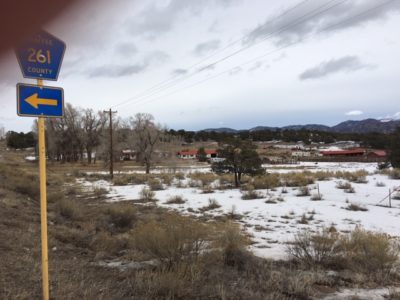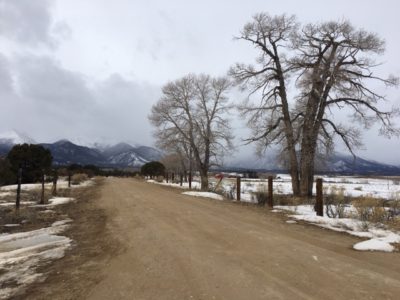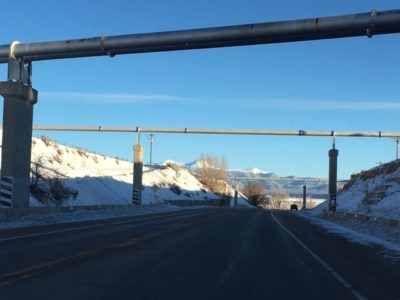 Near the end of nearly an eight-hour session, including more than four hours of a public hearing on the Centerville Ranch sketch plan proposal, the Board of Chaffee County Commissioners voted to continue the session to a special meeting to be held at 5 p.m. Feb. 21 at the Chaffee County Fairgrounds. Commissioners confirmed that public comment will be allowed at the special meeting.
Near the end of nearly an eight-hour session, including more than four hours of a public hearing on the Centerville Ranch sketch plan proposal, the Board of Chaffee County Commissioners voted to continue the session to a special meeting to be held at 5 p.m. Feb. 21 at the Chaffee County Fairgrounds. Commissioners confirmed that public comment will be allowed at the special meeting.
The continuation will allow time for commissioners to absorb the scope of the project, and landowner and developer Jeff Ince to address two major concerns from the many raised; the number of lots on land zoned rural, and the exact outline and size of the agricultural area that Ince says would remain in agricultural production.
“Agricultural is not a zoning level, it’s a tax status. The plat note is the guarantee to the people of the county that it would remain in ag production,” said Chaffee County Planning Manager Jon Roorda, referencing an area identified as Tract A on the sketch plan, which Ince says is part of a negotiation to become a conservation easement. That proposed conservation easement is strung together via a narrow land corridor that intersects the lot phases. Based on the Chaffee County LUC, the development is also required to designate 21 acres as subdivision open space, but that areas have not been identified.

Owner Jeff Ince says that his Centerville Ranch proposal will include protecting historic ranch buildings.
“We don’t have a clear definition of what they are applying for, so we don’t know how big this is,” said Roorda.
The Centerville Ranch sketch plan proposal is quite possibly the largest planned subdivision ever to be proposed in Chaffee County. Located east of U.S. 285, the development is currently planned at 210 lots ranging in size from 1.04 to 8.4 acres spread across seven parcels totaling around 500 acres, as well as a 17-acre commercial area bordering U.S. 285 directly across from the Sugarshack. The highway is a designated Colorado Scenic and Historic Byway.
“I’m struggling to look at this as a subdivision — a development — or is it just a small town,” said Commissioner Rusty Granzella after listening to the applicant’s presentation. To which representative on the project Tracy Vandaveer replied that “It’s not that dense a development.”
During the hearing, Commissioner Keith Baker pointed out concerns over light pollution in a rural county. “You don’t notice the development in the daytime, but you drive up and down at night and you see there are a lot more houses in the rural areas than there used to be.”
More than 60 people signed up to speak during the public hearing, which began at 11:40 a.m. and continue until after 4 p.m. Those who spoke came out against the proposed project, citing a range of concerns about the proposal’s scope, size, as well as placing that much density in the middle of the county, away from municipal areas.
“For half a century citizens of this county have expressed a preference, beginning with the comp plan in 1971 that we want development in small lots around municipal areas, said Sig Jaastad. “This was confirmed in 2001, in the citizen’s roundtable, and confirmed by Envision Chaffee County. It’s clear our land use code is inconsistent with those objectives. To continue to make interpretations on applications that wind up as inconsistent with the citizens have asked for is not good … Studies have shown that the cost to the community of this kind of rural residential development does not pay for the (county) services that it absorbs.”

CR 263 traverses the ridge north of the proposed development, and east of U.S. 285 along the Centerville Cemetery.
Citizens voiced concerns over the impact on viewsheds along the Collegiate Peaks Scenic and Historic Byway and traffic loads.
“This is a national scenic byway, not just a state one. Its been in place for years,” said Keith Krebs. “The small lots are in the scenic view and this is precisely the kind of development that Envision sought to prevent.”
“The objective of the (comprehensive) plan is to focus new, higher density development around existing towns. This is 10 miles from a town and 5 miles from an existing developed area – Nathrop — and it doesn’t help address affordable housing ” said Doug Welch. “This does neither of those things and it destroys rural landscapes. Your comp plan is accurate, your LUC isn’t.”
More than one county residents echoed the view expressed by Ken Matthews who was there representing the Chaffee County Housing Policy Advisory Committee; “HPAC was formed after the 2016 housing needs assessment and we look at this project from other perspectives. Our comp plan requires that country look like country and city look like city. There are going to be no affordable housing units in Centerville. It’s not possible with land, wells [and] septic [systems]. This will not assist in the affordable housing dilemma here – it would hinder affordable housing issues and take our capacity to build away.”

The Centerville Ranch proposal lies to the east of U.S. 285, the Collegiate Peaks Scenic and Historic Byway. the Centerville Cemetery lies on the ridge to the right in this photo.
Other members of the public, including neighbors with deep wells, questioned proof of water to support such a large subdivision. They said they opposed the proposal’s current plan to sink individual wells and septic systems and worried aloud over impacts on wildlife and the elk wintering migration routes.
The development would meander along the ridgelines overlooking agricultural acreage, and it appears a significant portion of the homes would be visible from U.S. 285.
“We voted to tax ourselves for the goals of Envision – to keep our rural areas rural and development around our towns. This is an affront to Envision participants,” said JoAnn Allen. “Those who will live there probably will be second homes not contributing to the community. We’ll pay the price in traffic, air pollution, loss of our aquifers, threats to the scenic byway … they won’t contribute to our economy but stress our infrastructure. This subdivision will cut the heart out of our county.”
The sketch plan shows only one access point, across from the Sugarshack, causing many to comment about the access difficulties already being experienced by Mesa Antero residents.
Ince explained that the sketch plan outlines what he says is a 20 to 25 year build out. “It’s not going to happen overnight. So building acceleration and deceleration lanes before they are warranted makes no sense.” He added that he would do what CDOT (Colorado Dept. of Transportation) required as it is needed.
Roughly a third of the total proposed lots are 1 acre in size and all proposed lots would have private wells and septic systems. In contrast, other older subdivisions in Chaffee County, including Mesa Antero and Game Trail include less than half as many homes, have central wells, central septic systems and are not close to the scenic byway.
Water supply is one of the major questions the county says has to be clarified. “There’s legal water and physical water,” said Chair Greg Felt. “We rely on the legal availability of water as our standard, but there is statute here regarding the actual physical availability of water. Are you concerned about groundwater availability?”
“The wells for houses in the area aren’t that deep – 90 ft., and there are streams on this property,” said Tracy Vandeveer, representing the project, who went on to say that there has been no hydrological study. He said the cost of such a study is beyond most developers. “The U.S. Geological Survey shows there’s water there.”
“But isn’t that assuming all the lots in this area could reach it? Without proof of actual water, there are assumptions being made,” said Baker.

The Centerville Ranch includes the historic Centerville Cemetery.
“Every subdivision you approve has assumptions,” said Vandaveer.
To which Baker replied, “An assumption is something that you can’t know – we’ve accepted an augmentation certificate in the past, but never on something this big.”
“By statute, the government has to make sure there is sufficient quantity and quality of water for developments of 50 lots and above,” said County Attorney Jenny Davis, who explained that there’s a calculation of average gallons per day, which translates to acre-feet of water for an average home per year.
“A hydrological study is needed,” said Felt. “Your well is not going to constrain itself from depletion only from under your 1 acre lots. A basin fill doesn’t hold near as much as true alluvial deposits. We need the study.”
Commissioners went on to explain that approval of a sketch plan would not necessarily approve the project; it would allow for dozens of local, state and federal entities to weigh in on the project, from the CDOT to the Environmental Protection Agency, Colorado Parks and Wildlife, the U.S. Forest Service, the Upper Ark Water Conservancy, among many others.
“Commissioner Baker sited things in Land Use Code because of his concerns,” said Davis. Baker had previously cited questions directly related to whether or not the sketch plan complies with land use code; specifically noting not just the 1971 Comprehensive Plan, but Chadwick, Roundtable and the Envision work, as well as state water statutes.
Felt said that the county-operated based on land use code and is working with an out-of-date Comprehensive Plan. For the benefit of the public in the meeting, he explained that when accepted, the new plan may well translate into changes in the LUC (Land Use Code). He explained that over the past two years the Envision process has surfaced a citizen viewpoint that will be taken into account as a new Comp Plan is developed.
Vandaveer objected, saying that the county is run by land use code and projects have to be reviewed by whether they meet land use code, not Envision. According to Vandaveer, the Centerville Ranch proposal, even in its current form, does (meet code).
“Physical water, wildlife, scenic viewsheds, these are statute items,” said Felt.
“We’re in a lot more detail at this point than we need to,” said Vandaveer.
To which Felt replied, “Given the significance of this project and the investment you’re contemplating I feel we’re doing you a favor.”
Ince interjected, saying that he appreciated all the public comments, and reiterated his wish to do his best to protect the ag land the development would surround as well as the historic buildings and cemetery. “One reason for the one-acre lots is the clustering concept, and the other part is affordable housing within the context of Chaffee County real estate. Regarding light pollution, this will have night light mitigation and we’re going to open up more passage for wildlife. This will have an HOA (Homeowners Association), covenants, architectural control and no short-term rentals.”
Ince said he was already at work on adjusting the sketch plan, reducing the density of the project, working to preserve the existing historic ranch structures and increasing the wildlife corridors. He added he would use the time until the next meeting to do what he could on the application to address the public’s concerns.







Thanks for the comprehensive coverage of this exhausting day. Your content and quotes are highly accurate and far more useful than what the competition provided. The day after sitting through all this, I drove up and around the property perimeter. Clearly, a project even half this size,at this location is an unforgivable detriment to our County, for all the reasons cited. The least of which is the access to/from Hwy 285, which required much patience and nerves of steel to access/exit safely at mid-morning. Imagine the carnage with even a few new residents at this horrible, view-impaired intersection?